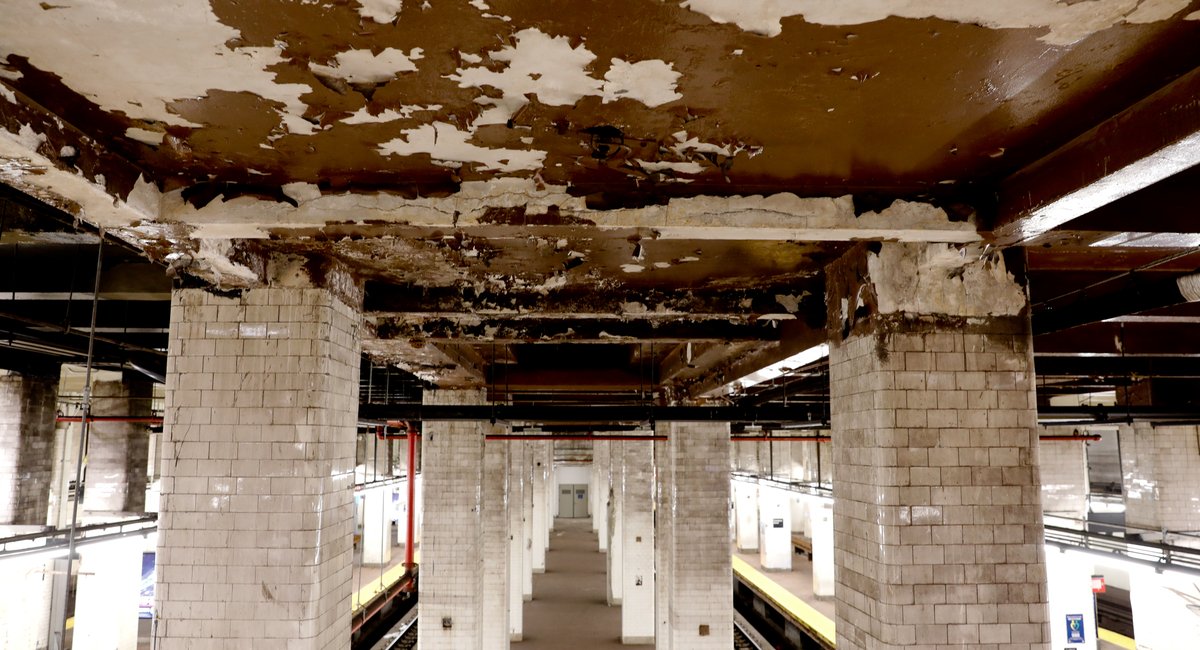Two of New York City’s most historic — and dilapidated — subway stations are due for renovations that aim to restore the spaces to their original glory.
The MTA is planning “historically sensitive” repairs at the Chambers Street station near City Hall and the 190th Street station in Washington Heights. The plan was revealed in a request for bids published by the MTA last year. The work is estimated to cost at least $100 million, and records show it’s expected to take two years to complete once the agency hires a contractor.
At Chambers Street, nearly every single white-tiled column on the J train platform is chipped, or missing tiles. Most of the columns have graffiti. Peeled paint dangles from the ceiling like bats in a cave.
Built in 1904 as part of the city’s first subway line, the station is tucked beneath the Municipal Building, and has a white-tiled domed entrance on the plaza above. Its interior — adorned with mosaics and plaques — was once celebrated for its Beaux Arts design.
But after decades of neglect, the station has become a symbol of disrepair in the mass transit system.
Anna Worwa, 47, said she noticed how dingy the Chambers station was on her first visit 18 years ago. Not much has changed since then.
“I was very surprised when I came here,” she said. “How disgusting this station is and, like, smelly.”
A man smokes a cigarette inside the Chambers Street station, which already has soot caked on its walls.
Stephen Nessen
The National Register of Historic Places lays out the station has original glass wall tiles, a set of 10 eagle plaques made by the Grueby Faience Company and other “unifying decorative elements that are remarkable for their material quality and level of craftsmanship.”
But that craftsmanship is easy to miss. Riders are more likely to associate the station with the grime, soot and rust that covers its walls and ceilings. Several of the eagle plaques, for example, are severely damaged.
The Chambers Street station, which opened in 1904 as part of the city’s first subway line, is showing its age.
Stephen Nessen
“We shouldn’t have the system looking like this,” said Beverly Alexander, 60, who works in the Municipal Building. “Everybody comes through here, it’s right off the [Brooklyn] Bridge, too. A lot of tourists.”
The MTA said it plans for a contractor to clean and restore all the station’s historic elements. The agency said in its bid documents that it plans to preserve the station’s character, while also adding modern features like new stairs and ramps for people who use wheelchairs. It would also add new artwork.
Even the wayfinding signs at the Chambers Street station are in need of repair.
Stephen Nessen
The 190th Street station on the A line — which opened in 1932 — is in similar shape.
Also listed in the National Register of Historic Places, federal records note one of its entrances was built in Tudor Gothic style, and is adorned with granite and stone that mimics the design of nearby Fort Washington and Fort Tryon Park.
Its interior once featured “simple but colorful, whimsical, tile work,” according to the register. Many of those tiles are now broken, and their colors have become drab.
Much like Chambers Street, the ceiling is also crumbling above the subway tracks at the 190th Street station uptown.
Clayton Guse
The station, which is tucked 140 feet beneath the park, has some of the deepest platforms in the entire subway system. Its top entrance, known to locals in part because its set of elevators offer a shortcut to the street, has a medieval, castle-like appearance.
“My sister, when she came she got real excited because she said it looked like something from the Hobbits,” Washington Heights resident Patricia Finnegan, 69, said. “Because you walk right into the mountain.”
The station has another entrance on Bennett Avenue, which is tucked into the side of the hill. Its old squeaky green doors lead to a long, shabby tunnel towards the platforms.
A Tudor Gothic stone building acts as the top entrance to the 190th Street station.
Clayton Guse
The MTA plans to build new automated doors that comply with the Americans with Disabilities Act. The work will add ramps between the station’s lower mezzanine to its platforms (despite having elevators, the station is not wheelchair accessible).
Other planned renovations include repairs to granite blocks, stonework and masonry joints. The parapets and coping stones at the station will be repointed. Decorative arched grilles and gates, as well as stone tracery, arches and sills will be replaced.
“I love the history. I love the feeling that you’re in a place that feels a little bit older,” Jessica Frey, 37, said as she left the station with her toddler in a stroller. “But anytime that the doors don’t work, that’s the problem. So working would be good.”


Leave a Reply